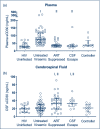Cerebrospinal fluid soluble CD30 elevation despite suppressive antiretroviral therapy in individuals living with HIV-1
- PMID: 32175087
- PMCID: PMC7043898
- DOI: 10.1016/S2055-6640(20)30006-6
Cerebrospinal fluid soluble CD30 elevation despite suppressive antiretroviral therapy in individuals living with HIV-1
Abstract
Objectives: The aim of this study was to assess soluble CD30 (sCD30), a protein that colocalises with HIV-1 RNA and DNA in lymphoid cells and tissues, in cerebrospinal fluid (CSF) as a marker of HIV-1 infection in the central nervous system (CNS).
Methods: This was a cross-sectional study using archived samples from two clinical cohorts. Soluble CD30 concentrations were measured in paired CSF and plasma from untreated viraemic individuals (n=52), individuals on suppressive antiretroviral therapy (ART) (n=33), HIV-1 controllers (n=10), participants with CSF HIV-1 'escape' (n=11) and controls without HIV-1 infection (n=16). Nonparametric tests were used to compare levels across groups and evaluate correlations with HIV-1 RNA, CSF neurofilament light chain protein (NFL) and neopterin.
Results: Compared with controls (median 30 ng/mL, interquartile range [IRQ] 23-50), plasma sCD30 levels were elevated in viraemic participants (75 ng/mL, 52-116; P<0.001), but not in those on suppressive ART (38 ng/mL, 32-62). In contrast, CSF sCD30 levels were elevated in ART-suppressed individuals (34 ng/mL, 19-46; P=0.001) and in those with CSF 'escape' (33 ng/mL, 27-40; P=0.004) compared with controls (18 ng/mL, 11-23), but not in untreated viraemic individuals. No association was observed between CSF sCD30 and plasma HIV-1 RNA, concurrent or nadir CD4+ T cell count, duration of infection or plasma sCD30. CSF sCD30 correlated with CSF NFL (r=0.34, P=0.001).
Conclusions: In contrast to plasma, sCD30 levels are elevated in the CSF of individuals with HIV-1 infection who are on suppressive ART. Elevated levels of sCD30 in the CSF may be an indicator of persistent CNS HIV-1 infection, although the mechanism underlying this elevation warrants further investigation.
Keywords: CD30; HIV-1; central nervous system (CNS); cerebrospinal fluid (CSF); reservoir.
© 2020 The Authors. Journal of Virus Eradication published by Mediscript.
Figures




Similar articles
-
Cerebrospinal fluid CXCL10 is associated with the presence of low level CSF HIV during suppressive antiretroviral therapy.J Neuroimmunol. 2021 Apr 15;353:577493. doi: 10.1016/j.jneuroim.2021.577493. Epub 2021 Jan 21. J Neuroimmunol. 2021. PMID: 33571816 Free PMC article.
-
Plasma Concentration of the Neurofilament Light Protein (NFL) is a Biomarker of CNS Injury in HIV Infection: A Cross-Sectional Study.EBioMedicine. 2015 Nov 22;3:135-140. doi: 10.1016/j.ebiom.2015.11.036. eCollection 2016 Jan. EBioMedicine. 2015. PMID: 26870824 Free PMC article.
-
Soluble CD30 levels in plasma and cerebrospinal fluid in multiple sclerosis, HIV infection and other nervous system diseases.Acta Neurol Scand. 1997 Feb;95(2):99-102. doi: 10.1111/j.1600-0404.1997.tb00077.x. Acta Neurol Scand. 1997. PMID: 9059729
-
What can characterization of cerebrospinal fluid escape populations teach us about viral reservoirs in the central nervous system?AIDS. 2019 Dec 1;33 Suppl 2:S171-S179. doi: 10.1097/QAD.0000000000002253. AIDS. 2019. PMID: 31790378 Review.
-
Cerebrospinal Fluid HIV Escape from Antiretroviral Therapy.Curr HIV/AIDS Rep. 2015 Jun;12(2):280-8. doi: 10.1007/s11904-015-0267-7. Curr HIV/AIDS Rep. 2015. PMID: 25860317 Review.
Cited by
-
Cerebrospinal fluid CXCL10 is associated with the presence of low level CSF HIV during suppressive antiretroviral therapy.J Neuroimmunol. 2021 Apr 15;353:577493. doi: 10.1016/j.jneuroim.2021.577493. Epub 2021 Jan 21. J Neuroimmunol. 2021. PMID: 33571816 Free PMC article.
-
Characterization of Macrophage-Tropic HIV-1 Infection of Central Nervous System Cells and the Influence of Inflammation.J Virol. 2022 Sep 14;96(17):e0095722. doi: 10.1128/jvi.00957-22. Epub 2022 Aug 17. J Virol. 2022. PMID: 35975998 Free PMC article.
-
Biomarkers of Activation and Inflammation to Track Disparity in Chronological and Physiological Age of People Living With HIV on Combination Antiretroviral Therapy.Front Immunol. 2020 Oct 9;11:583934. doi: 10.3389/fimmu.2020.583934. eCollection 2020. Front Immunol. 2020. PMID: 33162998 Free PMC article. Review.
-
The Contributions of Clinical Pharmacology to HIV Cure Research.Clin Pharmacol Ther. 2021 Aug;110(2):334-345. doi: 10.1002/cpt.2237. Epub 2021 Apr 18. Clin Pharmacol Ther. 2021. PMID: 33763860 Free PMC article. Review.
-
CD4 dim CD8 bright T cells are inversely associated with neuro-inflammatory markers among people with HIV.AIDS. 2024 Jan 1;38(1):1-7. doi: 10.1097/QAD.0000000000003743. Epub 2023 Oct 3. AIDS. 2024. PMID: 37792358 Free PMC article.
References
-
- Biswas P, Cozzi-Lepri A, Delfanti F et al. . Significant link between sCD30 changes and HIV viremia in patients treated with HAART. J Med Virol 2006; 78 ( 12): 1513– 1519. - PubMed
-
- Biswas P, Mantelli B, Delfanti F et al. . CD30 ligation differentially affects CXCR4-dependent HIV-1 replication and soluble CD30 secretion in non-Hodgkin cell lines and in gamma delta T lymphocytes. Eur J Immunol 2003; 33 ( 11): 3136– 3145. - PubMed
-
- Falini B, Pileri S, Pizzolo G et al. . CD30 (Ki-1) molecule: a new cytokine receptor of the tumor necrosis factor receptor superfamily as a tool for diagnosis and immunotherapy. Blood 1995; 85 ( 1): 1– 14. - PubMed
Publication types
Grants and funding
LinkOut - more resources
Full Text Sources
Research Materials
